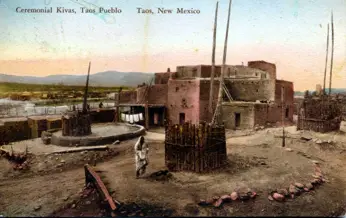Difference between revisions of "Pueblo" - New World Encyclopedia
| Line 66: | Line 66: | ||
{{Native American Housing}} | {{Native American Housing}} | ||
| + | |||
| + | {{credits|431536867}} | ||
Revision as of 22:46, 6 June 2011
- This article is about the communities of apartment-like structures in the Southwestern United States of America. For the people who live in these communities, see Pueblo People.
Pueblo is a term used to describe modern (and ancient) communities of Native Americans in the Southwestern United States of America. The first Spanish Explorers of the Southwest used this term to describe communities that consisted of apartment-like structures made from stone, adobe mud, and other local material. These structures were usually multi-storeyed buildings surrounding an open plaza and were occupied by hundreds to thousands of Pueblo People.
Etymology and usage
The Castilian word pueblo, evolved from the Latin word populus (people), meaning "town."
On the central Spanish meseta the unit of settlement was and is the pueblo; that is to say, the large nucleated village surrounded by its own fields, with no outlying farms, separated from its neighbours by some considerable distance, sometimes as much as ten miles or so. The demands of agrarian routine and the need for defence, the simple desire for human society in the vast solitude of the plains,dictated that it should be so. Nowadays the pueblo might have a population running into thousands. Doubtless they were smaller in the early middle ages, but we should probably not be far wrong if we think of them as having had populations of some hundreds.[1]
Of the federally recognized Native American communities in the Southwest, those designated by the King of Spain as Pueblo at the time treaties ceded Spanish territory to the United States are now legally recognized by the Bureau of Indian Affairs as Pueblo. Some of the Pueblo also came into the United States by treaty with Mexico, which briefly gained jurisdiction over territory in the Southwest ceded by Spain. There are 21 federally recognized Pueblos[2] that are home to Pueblo people. As listed by their official federal names:
|
|
|
Historical places
Pre-Columbian towns and villages in the Southwest were located in defensive positions, for example, on high steep mesas such as Acoma. Anthropologists and official documents often refer to earlier residents of the area as pueblo cultures. For example, the National Park Service states, "The Late Puebloan cultures built the large, integrated villages found by the Spaniards when they began to move into the area."[3] The people of some pueblos, such as Taos Pueblo, still inhabit centuries-old adobe pueblo buildings.[4] Residents often maintain other homes outside the historic pueblos.[4] Adobe and light construction methods resembling adobe now dominate architecture at the many pueblos of the area, in nearby towns or cities and in much of the American Southwest.[5]
In addition to contemporary pueblos, there are numerous ruins of archeological interest throughout the Southwest. Some are of relatively recent origin; others are of prehistoric origin such as the cliff dwellings and other habitations of the Ancient Pueblo Peoples or Anasazi.[6]
See also
- Ancient Pueblo Peoples
- Pueblo Revolt
Notes
- ↑ Fletcher, Richard A. (1984) Saint James's Catapult: the life and times of Diego Gelmírez of Santiago de Compostela, Oxford: Oxford University Press, ISBN 0-19-822581-4 (on-line text, ch. 1)
- ↑ "Indian Entities Recognized and Eligible To Receive Services From the United States Bureau of Indian Affairs; Notice" Federal Register 12 July 2002, Part IV, Department of Interior, Bureau of Indian Affairs
- ↑ "The Origins of the Salinas Pueblos," in In the Midst of a Loneliness: The Architectural History of the Salinas Missions, US National Parks Service
- ↑ 4.0 4.1 Gibson, Daniel (2001) Pueblos of the Rio Grande: A Visitor's Guide, Rio Nuevo Publishers, Tucson, Arizona, p. 78, ISBN 1-887896-26-0
- ↑ Paradis, Thomas W. (2003) Pueblo Revival Architecture, Dept. of Geography, Planning and Recreation, Northern Arizona University
- ↑ Gibson, Daniel (2001) "Pueblo History," in Pueblos of the Rio Grande: A Visitor's Guide, Tucson, Arizona: Rio Nuevo Publishers, pp. 3-4, ISBN 1-887896-26-0
ReferencesISBN links support NWE through referral fees
- Fletcher, Richard A. Saint James's Catapult: the life and times of Diego Gelmírez of Santiago de Compostela. Oxford: Oxford University Press, 1984. ISBN 0198225814
- Gibson, Daniel. Pueblos of the Rio Grande: A Visitor's Guide. Tucson, AZ: Rio Nuevo Publishers, 2001. ISBN 1887896260
External links
- The SMU-in-Taos Research Publications digital collection contains nine anthropological and archaeological monographs and edited volumes representing the past several decades of research, primarily on Pueblo Indian ruins and excavations, at the SMU-in-Taos (Fort Burgwin) campus near Taos, New Mexico, including Papers on Taos archaeology, Taos archeology, Pueblo through time: eight centuries of change in a northern Rio Grande pueblo and Excavations at Pot Creek Pueblo.
| |||||
Credits
New World Encyclopedia writers and editors rewrote and completed the Wikipedia article in accordance with New World Encyclopedia standards. This article abides by terms of the Creative Commons CC-by-sa 3.0 License (CC-by-sa), which may be used and disseminated with proper attribution. Credit is due under the terms of this license that can reference both the New World Encyclopedia contributors and the selfless volunteer contributors of the Wikimedia Foundation. To cite this article click here for a list of acceptable citing formats.The history of earlier contributions by wikipedians is accessible to researchers here:
The history of this article since it was imported to New World Encyclopedia:
Note: Some restrictions may apply to use of individual images which are separately licensed.
